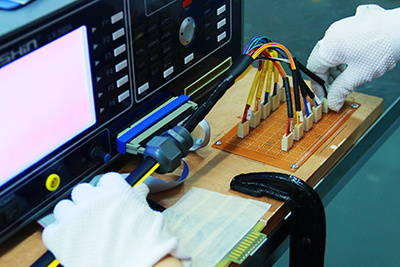Unlocking Efficiency: The Power of Advanced R-Type Transformers
Jul 08,2025
1. What Are R-Type Transformers?
The **R-Type transformer**, characterized by its advanced core design and construction, enhances energy conversion in electrical systems. These transformers utilize a unique winding arrangement and core material that minimizes energy loss and improves overall efficiency. R-Type transformers are particularly known for their ability to handle high voltages, making them essential in large-scale power distribution and industrial applications.
2. Design Features of R-Type Transformers
2.1 Core Construction
The core of an R-Type transformer is typically made from high-quality silicon steel, which reduces hysteresis losses. The core's geometry is designed to optimize magnetic flux, ensuring that energy is transferred with minimal waste. The laminated structure of the core further enhances performance by minimizing eddy currents.

2.2 Winding Configuration
R-Type transformers feature a unique winding configuration that allows for better coupling between primary and secondary coils. This configuration ensures that energy transfer is both efficient and effective, allowing these transformers to operate at optimal levels under various load conditions.
2.3 Insulation Systems
The insulation used in R-Type transformers is engineered to withstand high temperatures and electrical stresses. High-grade materials ensure that the transformer remains functional even under adverse conditions, prolonging its lifespan and enhancing reliability.
3. Advantages of Using R-Type Transformers
3.1 High Efficiency
One of the primary advantages of R-Type transformers is their **high efficiency**. These transformers are designed to minimize energy losses, making them ideal for applications requiring low operational costs and optimal performance. Their efficiency leads to substantial energy savings, making them a preferred choice for many industrial applications.
3.2 Reduced Noise Levels
R-Type transformers exhibit lower noise levels compared to traditional transformers. This is due to their design, which minimizes vibrations and mechanical noise, making them suitable for environments where noise reduction is crucial.
3.3 Versatility in Applications
The versatility of R-Type transformers makes them suitable for various applications, from power generation and distribution to commercial and industrial use. Their adaptability allows them to function effectively in different environments, enhancing their significance in the electrical engineering sector.
3.4 Enhanced Load Capacity
These transformers can handle variations in load with ease, providing stable performance even during fluctuating demand. This capability makes R-Type transformers invaluable in systems where load conditions can change frequently.
4. Applications of R-Type Transformers
4.1 Power Generation Facilities
R-Type transformers are extensively used in power generation facilities, where they play a crucial role in stepping up or stepping down voltage levels. This ensures that electricity is transmitted efficiently over long distances, reducing transmission losses and enhancing grid stability.
4.2 Industrial Settings
In industrial settings, R-Type transformers are utilized for their ability to handle high power demands. They are commonly found in manufacturing plants, steel mills, and other heavy industries where consistent and reliable power supply is paramount.
4.3 Renewable Energy Systems
As the world shifts towards renewable energy sources, R-Type transformers are becoming increasingly important in solar and wind energy systems. Their efficiency and reliability are essential for converting and managing energy from these sources effectively.
4.4 Commercial Applications
In commercial buildings, R-Type transformers help in distributing electricity throughout the premises. Their ability to manage peak loads and provide stable power makes them ideal for office buildings, shopping centers, and other large facilities.
5. Importance of R-Type Transformers in Power Systems
R-Type transformers are integral to the modern power grid, serving as the backbone of electricity distribution. Their design and efficiency contribute significantly to the overall reliability of power systems. By reducing energy losses and maintaining stable voltage levels, these transformers ensure that electricity remains accessible and affordable for consumers. Furthermore, their adaptability to various applications allows them to meet the evolving demands of the energy sector.
6. Future Trends in Transformer Technology
6.1 Smart Transformers
The future of R-Type transformers lies in the integration of smart technology. Smart transformers equipped with sensors and communication capabilities can provide real-time monitoring and data analysis, enhancing operational efficiency and preventative maintenance.
6.2 Eco-Friendly Materials
As environmental concerns rise, the use of eco-friendly materials in transformer construction is becoming a priority. Future R-Type transformers may utilize recyclable materials and energy-efficient designs to minimize their carbon footprint.
6.3 Enhanced Thermal Management
Advancements in thermal management technologies will allow R-Type transformers to operate at higher efficiency levels, even in extreme conditions. Improved cooling systems will enhance performance and extend the lifespan of these vital components.
7. Maintenance and Reliability of R-Type Transformers
7.1 Routine Inspections
Regular maintenance is essential for ensuring the optimal performance of R-Type transformers. Routine inspections can identify potential issues before they escalate, allowing for timely repairs and minimizing downtime.
7.2 Condition Monitoring Systems
Implementing advanced condition monitoring systems can enhance the reliability of R-Type transformers. These systems provide continuous data on transformer performance, enabling proactive maintenance strategies that extend the lifespan of the equipment.
7.3 Training and Certification
Ensuring that technicians are trained and certified in the maintenance of R-Type transformers is crucial. A well-trained workforce can effectively manage transformer systems, ensuring that they operate at peak efficiency.
8. Conclusion
Advanced R-Type transformers are a critical component in today's electrical engineering landscape, offering numerous advantages such as high efficiency, reduced noise levels, and versatility in applications. Their role in power generation, industrial settings, and renewable energy systems underscores their importance in achieving a reliable and efficient power supply. As technology continues to evolve, R-Type transformers will play a pivotal role in shaping the future of energy management, ensuring that they remain at the forefront of electrical engineering innovations.
Related Posts








